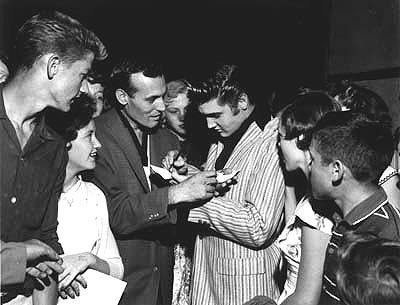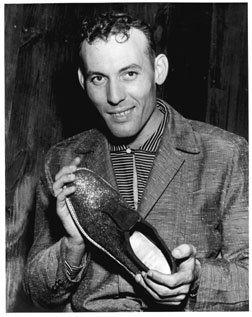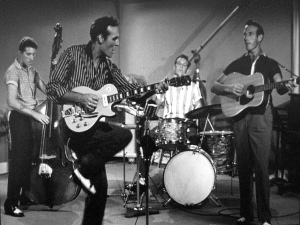<Back to Index>
- Songwriter and Singer Carl Lee Perkins, 1932
PAGE SPONSOR
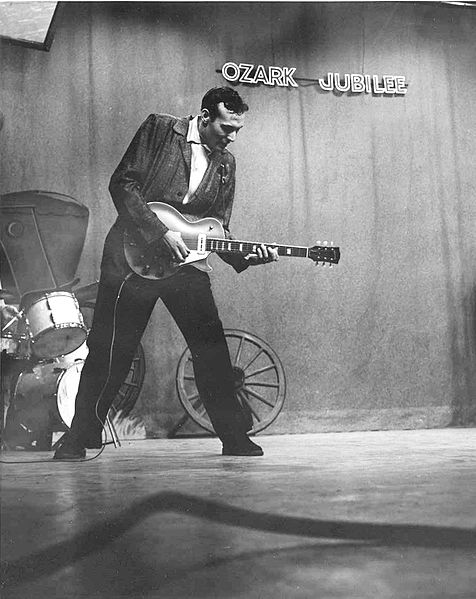
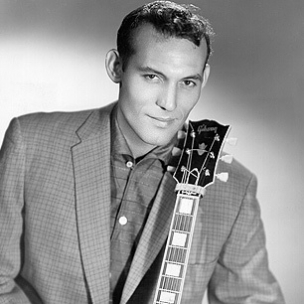
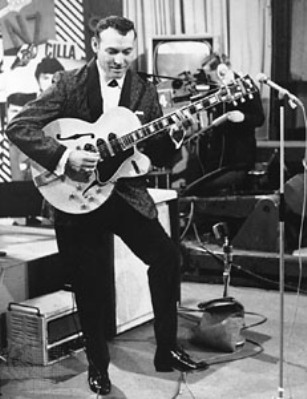
Carl Lee Perkins (April 9, 1932 – January 19, 1998) was an American rockabilly musician who recorded most notably at Sun Records Studio in Memphis, Tennessee, beginning during 1954. His best known song is "Blue Suede Shoes".
According to Charlie Daniels, "Carl Perkins' songs personified the rockabilly era, and Carl Perkins' sound personifies the rockabilly sound more so than anybody involved in it, because he never changed." Perkins' songs were recorded by artists (and friends) as influential as Elvis Presley, The Beatles, Jimi Hendrix, and Johnny Cash, which further cemented his place in the history of popular music.
Called "the King of Rockabilly", he was inducted into the Rock and Roll, the Rockabilly, and the Nashville Songwriters Halls of Fame; and was a Grammy Hall of Fame Award recipient.
Perkins was the son of poor sharecroppers near Tiptonville, Tennessee. He grew up hearing Southern gospel music sung by whites in church, and by black field workers when he started working in the cotton fields at age six. During spring and autumn, the school day would be followed by several hours of work in fields. During the summer, workdays were 12 – 14 hours, "from can to can't." Carl and his brother Jay together would earn 50 cents a day. With all family members working and not having any credit, there was enough money for beans and potatoes, some tobacco for Carl's father Buck, and occasionally the luxury of a five cent bag of hard candy.
During Saturday nights Carl would listen to the radio with his father and hear the Grand Ole Opry, and Roy Acuff's broadcasts on the Opry inspired him to ask his parents for a guitar. Because they could not afford a real guitar, Carl's father fashioned one from a cigar box and a broomstick. When a neighbor in tough straits offered to sell his dented and scratched Gene Autry model guitar with worn out strings, Buck purchased it for a couple of dollars.
For the next year Carl taught himself parts of Acuff's "Great Speckled Bird" and "The Wabash Cannonball", which he had heard on the Opry. He also cited the fast playing and vocals of Bill Monroe as an early influence.
Carl began learning more about playing his guitar from a fellow field worker named John Westbrook who befriended him. "Uncle John," as Carl called him, was an African American in his sixties who played blues and gospel on his battered acoustic guitar. Most famously, "Uncle John" advised Carl when playing the guitar to "Get down close to it. You can feel it travel down the strangs, come through your head and down to your soul where you live. You can feel it. Let it vib-a-rate." Because Carl could not afford new strings when they broke, he retied them. The knots would cut into his fingers when he tried to slide to another note, so he began bending the notes, stumbling onto a type of "blue note."
Carl
was recruited to be a member of the Lake County Fourth Grade Marching
Band, and because of the Perkins' limited finances, was given a new
white shirt, cotton pants, white band cap and red cape by Miss Lee
McCutcheon, who was in charge of the band. During
January 1947, Buck Perkins moved his family from Lake County to Madison
County. A replacement radio which operated by electricity rather than a
battery and the proximity of Memphis made it possible for Carl to hear a
greater variety of music. At age fourteen years, using the I IV V chord progression common to country songs of the day, he wrote what came to be known around Jackson as "Let Me Take You To the Movie, Magg" (the song would convince Sam Phillips to sign Perkins to his Sun Records label).
Perkins and his brother Jay had their first paying job (in tips) as entertainers at the "Cotton Boll" tavern on Highway 45 some twelve miles south of Jackson, starting on Wednesday nights during late 1946. Carl was only 14 years old. One of the songs they played was an uptempo, country blues shuffle version of Bill Monroe's "Blue Moon of Kentucky". Free drinks were one of the perks of playing in a tavern, and Carl drank four beers that first night. Within a month Carl and Jay began playing Friday and Saturday nights at the Sand Ditch tavern near the western boundary of Jackson. Both places were the scene of occasional fights, and both of the Perkins Brothers gained a reputation as fighters.
During the next couple of years the Perkins Brothers began playing other taverns, including El Rancho, The Roadside Inn, and the Hilltop around Bemis and Jackson as they became well known. Carl persuaded his brother Clayton to play the bass fiddle to complete the sound of the band.
Perkins began performing regularly on WTJS-AM in Jackson during the late 1940s as a sometime member of the Tennessee Ramblers. He also appeared on Hayloft Frolic where he performed two songs, sometimes including "Talking Blues" as done by Robert Lunn on the Grand Ole Opry. Perkins and then his brothers began appearing on The Early Morning Farm and Home Hour. Overwhelmingly positive listener response resulted in a 15 minute segment sponsored by Mother's Best Flour. By the end of the 1940s, the Perkins Brothers were the best known band in the Jackson area.
Perkins had day jobs during most of these early years, working first at picking cotton, then at Day's Dairy in Malesus, then at a mattress factory and in a battery plant. He then worked as a pan greaser for the Colonial Baking Company from 1951 through 1952.
During January 1953, Perkins married a woman he had known for a number of years, Valda Crider. When his job at the bakery was reduced to part time, Valda, who had her own job, encouraged Carl to begin working the taverns full time. He began playing six nights a week. Late the same year he added W.S. "Fluke" Holland to the band as a drummer, who had not any previous experience as a musician but had a good sense of rhythm.
Malcolm Yelvington remembered the Perkins brothers from 1953 when they played in Covington, Tennessee. He noted that Carl had a very unusual blues like style all his own. One of Carl's friends had a tape recorder, and he had used it to make tapes of his materials that he sent to Columbia and RCA. He never heard back from them.
During July 1954, Perkins and his wife heard a new release of "Blue Moon of Kentucky" by Elvis Presley, Scotty Moore and Bill Black on the radio. Valda exclaimed, "Listen! They play like y'all! It sounds like you!" After recording the take of the song that was released, Presley exclaimed, "That sounds like Carl Perkins!" Later, Presley told Perkins that he had traveled to Jackson and seen Perkins and his group playing at El Rancho. As "Blue Moon of Kentucky faded out, Carl said, "There's a man in Memphis who understands what we're doing. I need to go see him."
Years
later fellow musician Gene Vincent told an interviewer that, rather
than "Blue Moon of Kentucky" being a "new sound", "a lot of people were
doing it before that, especially Carl Perkins."
Perkins successfully auditioned for Sam Phillips at Sun Records during early October 1954. "Movie Magg" and "Turn Around" were released on the Phillips owned Flip label (151) March 19, 1955, with "Turn Around" becoming a regional success. With the song getting airplay across the South and Southwest, Perkins was booked to appear along with Elvis Presley at theaters in Marianna and West Memphis, Arkansas. Commenting on the audience reaction to both Presley and himself Perkins said, "When I'd jump around they'd scream some, but they were gettin' ready for him. It was like TNT, man, it just exploded. All of a sudden the world was wrapped up in rock."
Johnny Cash and the Tennessee Two were the next musicians to be added to the performances by Sun musicians. During the summer of 1955 there were junkets to Little Rock, Forrest City, Arkansas, Corinth and Tupelo, Mississippi. Again performing at El Rancho, the Perkins brothers were involved in an automobile accident. A friend, who had been driving, was pinned by the steering wheel. Perkins managed to drag him from the car, which had begun burning. Clayton had been thrown from the car, but was not injured seriously.
Another Perkins' tune, "Gone Gone Gone", released in October 1955 by Sun, was also a regional success. It was backed by the more traditional "Let The Juke Box Keep On Playing," complete with fiddle, "Western Boogie" bass line, steel guitar and weepy vocal.
Commenting on Perkins' playing, Sam Phillips has been quoted as saying that, "I knew that Carl could rock and in fact he told me right from the start that he had been playing that music before Elvis came out on record... I wanted to see whether this was someone who could revolutionize the country end of the business."
That same autumn, Perkins wrote "Blue Suede Shoes"
after seeing a dancer in a tavern get angry with his date for scuffing
up his blue suede shoes. Several weeks later, on December 19, 1955,
Perkins and his band recorded the song during a session at Sun Studio in
Memphis. Phillips suggested changes to the lyrics ("Go, cat, go") and
the band changed the end of the song to a "boogie vamp".
Presley left Sun for a larger opportunity with RCA in November, and on December 19, 1955, Phillips, who had begun recording Perkins in late 1954, told Perkins, "Carl Perkins, you're my rockabilly cat now." Released on January 1, 1956, "Blue Suede Shoes" was a massive chart success. In the United States, it scored No. 1 on Billboard magazine's country music charts (the only No. 1 success he would have) and No. 2 on Billboard's Best Sellers popular music chart. On March 17, Perkins became the first country artist to score No. 3 on the rhythm & blues charts. That night, Perkins performed the song during his television debut on ABC - TV's Ozark Jubilee (Presley performed it for the second time that same night on CBS - TV's Stage Show; he'd first sung it on the program on February 11).
In the United Kingdom, the song became a Top Ten success,
scoring No. 10 on the British charts. It was the first record by a Sun
label artist to sell a million copies. The B side, "Honey Don't", was covered by The Beatles, Wanda Jackson and (in the 1970s) T. Rex. John Lennon sang lead on the song when the Beatles performed it before it was given to Ringo Starr to sing. Lennon also performed the song on the Lost Lennon Tapes.
After playing a show in Norfolk, Virginia, on March 21, 1956, the Perkins Brothers Band headed to New York City for a March 24 appearance on NBC - TV's Perry Como Show. Shortly before sunrise on March 22 near Dover, Delaware, Stuart Pinkham (aka Richard Stuart and Poor Richard) assumed duties as driver. After hitting the back of a pickup truck, their car went into a ditch of water about a foot deep, and Carl was lying face down in the water. Drummer Holland rolled Carl over, saving him from drowning. He had suffered three fractured vertebrae in his neck, a severe concussion, a broken collar bone, and lacerations all over his body in the crash. Carl remained unconscious for an entire day. The driver of the pickup truck, Thomas Phillips, a 40 year old farmer, died when he was thrown into the steering wheel. Carl's brother Jay had a fractured neck along with severe internal injuries.
On March 23, Bill Black, Scotty Moore and D.J. Fontana visited Perkins on their way to New York to appear with Presley the next day. D.J. Fontana recalled Perkins saying, "Of all the people, I looked up and there you guys are. You looked like a bunch of angels coming to see me." Black told him, "Hey man, Elvis sends his love," and lit a cigarette for him, even though the patient in the next bed was in an oxygen tent. A week later, Perkins was given a telegram from Presley (which had arrived on the 23rd), wishing him a speedy recovery.
Sam Philips had planned to surprise Perkins with a gold record on The Perry Como Show. "Shoes" had already sold more than 500,000 copies by March 22. Now, while Carl recuperated from the accident, "Blue Suede Shoes" scored No. 1 on most popular, R&B, and country regional music charts. It also scored No. 2 on the Billboard Hot 100 and country charts. Elvis Presley's "Heartbreak Hotel" scored number one on the pop and country charts, while "Shoes" did better than "Heartbreak" on the R&B charts. By mid April, more than one million copies of "Blue Suede Shoes" had been sold.
On April 3, while still recuperating in Jackson, Perkins would see Presley perform "Blue Suede Shoes" on his first Milton Berle Show appearance, which was his third performance of the song on national television. He also made references to it twice during an appearance on The Steve Allen Show. Although his version became more famous than Perkins', it only scored No. 20 on Billboard's popular music chart.
Perkins returned to live performances on April 21, 1956, beginning with an appearance in Beaumont, Texas, with the "Big D Jamboree" tour. Before resuming touring, Sam Phillips arranged a recording session at Sun with
Ed Cisco filling in for the still- recuperating Jay. By mid April,
"Dixie Fried", "Put Your Cat Clothes On", "Right String, Wrong Yo-Yo",
"You Can't Make Love to Somebody", "Everybody's Trying to Be My Baby", and "That Don't Move Me" had been recorded.
Beginning during early summer, Perkins was paid $1,000 to play just two songs a night on the extended tour of "Top Stars of '56." Other performers on the tour were Chuck Berry and Frankie Lymon and the Teenagers. When Perkins and the group entered the stage in Columbia, South Carolina, he was appalled to see a teenager with a bleeding chin pressed against the stage by the crowd. During the first guitar intermission of "Honey Don't" they were waved off stage and into a vacant dressing room behind a double line of police officers. Perkins was quoted as saying, "It was dangerous. Lot of kids got hurt. There was a lot of rioting going on, just crazy, man! The music drove 'em insane." Appalled by what he had seen and experienced, Perkins left the tour. Appearing with Gene Vincent and Lillian Briggs in a "rock 'n' roll show", he helped pull 39,872 people to the Reading Fair in Pennsylvania on a Tuesday night in late September. A full grand stand and one thousand people who stood in a heavy rain to hear Perkins and Briggs at the Brockton Fair in Mass.
Sun issued more Perkins songs in 1956: "Boppin' the Blues" / "All Mama's Children" (Sun 243), the B side co-written with Johnny Cash, "Dixie Fried" / "I'm Sorry, I'm Not Sorry" (Sun 249). "Matchbox" / "Your True Love" (Sun 261) came out in February 1957. "Boppin' the Blues" reached no. 47 on the Cash Box pop singles chart, no. 9 on the Billboard country and western chart, and no. 70 on the Billboard Top 100 chart.
"Matchbox" is considered a rockabilly classic. The day it was recorded, Elvis Presley visited the studio. Along with Johnny Cash (who left early), Perkins, Jerry Lee Lewis and Presley spent more than an hour singing gospel, country and rhythm - and - blues songs while a tape rolled. The casual session was called The Million Dollar Quartet by a local newspaper the next day, and it was eventually released on CD in 1990.
On February 2, 1957, Perkins again appeared on Ozark Jubilee, singing "Matchbox" and "Blue Suede Shoes". He also made at least two appearances on Town Hall Party in Compton, California in 1957 singing both songs. Those performances were included in the Western Ranch Dance Party series filmed and distributed by Screen Gems.
The 1957 film Jamboree included a Perkins performance of "Glad All Over" (not to be confused with The Dave Clark Five song of the same name), that ran 1:55. "Glad All Over," written by Aaron Schroeder, Sid Tepper, and Roy Bennett, was released by Sun in January 1958.
During 1958, Perkins moved to Columbia Records where he recorded songs such as "Jive After Five", "Rockin' Record Hop", "Levi Jacket (And a Long Tail Shirt)", "Pop, Let Me Have the Car", "Pink Pedal Pushers", "Anyway the Wind Blows", "Hambone", "Pointed Toe Shoes", and "Sister Twister".
He performed often in The Golden Nugget Casino in Las Vegas during 1962 and 1963, and also in nine Midwestern states and a tour of Germany.
During May 1964, Perkins toured England along with Chuck Berry. The Animals backed the two performers. On the last night of the tour, Perkins attended a party that turned out to be for him, and ended up sitting on the floor sharing stories, playing guitar, and singing songs while surrounded by The Beatles. Ringo Starr asked if he could record "Honey Don't". "Man," answered Perkins, "go ahead, have at it." The Beatles would cover "Matchbox", "Honey Don't" and "Everybody's Trying to Be My Baby" recorded by Perkins but adapted from a song originally recorded by Rex Griffin during 1936 with new music composed by Carl Perkins, a song with the same title also recorded by Roy Newman in 1938. The Beatles recorded two versions of "Glad All Over" in 1963. Another tour to Germany followed in the autumn.
Although he had been trying to rehabilitate himself by drinking only beer (but large amounts of it), during 1968, while on tour with the Johnny Cash troupe, Perkins began a four day drunk in Tulsa, Oklahoma, starting with a bottle of Early Times. Nevertheless, with the urging of Cash, he opened a show in San Diego, California, by playing four songs after seeing "four or five of me in the mirror," and while being able to see "nothin' but a blur." After drinking yet another pint of Early Times, he passed out on the tour bus. By morning he started hallucinating "big spiders, and dinosaurs, huge, and they were gonna step on me." The bus was parked on a beach at the ocean. He was tempted by yet another pint of whiskey that he had hidden. He took the bottle with him onto the beach and fell on his knees and said, "Lord... I'm gonna throw this bottle. I'm gonna show You that I believe in You. I sailed it into the Pacific... I got up, I knew I had done the right thing." Perkins and Cash, who had his own problems with drugs, then gave each other support to refrain from their drug of choice.
During 1968, Cash recorded the Perkins written "Daddy Sang Bass" (which incorporates parts of the American standard "Will the Circle Be Unbroken") and scored No. 1 on the country music charts for six weeks. Glen Campbell also covered the song, as did The Statler Brothers and Carl Story. "Daddy Sang Bass" was also a Country Music Association nominee for Song of the Year. Perkins also played lead guitar on the Cash smash single "A Boy Named Sue" which was No. 1 for five weeks on the country chart and No. 2 on the popular music chart. Perkins spent a decade in Cash's touring revue and appeared on The Johnny Cash Show. He played "Matchbox" with Cash and Derek and the Dominoes. Cash also featured Perkins in rehearsal jamming with José Feliciano and Merle Travis.
A Kraft Music Hall episode hosted by Cash on April 16, 1969 had Perkins singing his song "Restless". Country music fans may recognize The Statler Brothers' song, "Flowers on the Wall", which was also featured on the show.
During February 1969, Perkins joined with Bob Dylan to write "Champaign, Illinois". Dylan was recording in Nashville from February 12 through February 21 for an album that would be titled Nashville Skyline, and met Perkins when he appeared on The Johnny Cash Show on June 7. Dylan had written one verse of a song, but was stuck. After Perkins worked out a loping rhythm and improvised a verse ending lyric, Dylan said, "Your song. Take it. Finish it." The co-authored song was included in Perkins' 1969 album On Top.
Perkins was also united in 1969 by Columbia's Murray Krugman with a "rockabilly" group based in New York's Hudson Valley, the New Rhythm and Blues Quartet. Carl and NRBQ recorded "Boppin' the Blues" which featured the group backing him on songs like his staples "Turn Around" and "Boppin' the Blues" and included songs recorded separately by Perkins and NRBQ. One of his TV appearances with Cash was on the popular country series Hee Haw on February 16, 1974.
After a long legal struggle with Sam Phillips over royalties, Perkins gained ownership of his songs during the 1970s.
During 1981 Perkins recorded the song "Get It" with Paul McCartney, providing vocals and playing guitar with the former Beatle. This recording was included on the chart topping album Tug Of War released in 1982. This track also comprised the B-side of the title track single in a slightly edited form. One source states that Perkins "wrote the song with Paul McCartney." The song ends with a fade out of Perkins' impromptu laughter.
The "rockabilly" revival of the 1980s helped bring Perkins back into the limelight. During 1985, he re-recorded "Blue Suede Shoes" with Lee Rocker and Jim Phantom of the Stray Cats, as part of the soundtrack for the movie, Porky's Revenge.
In October 1985, George Harrison, Eric Clapton, Dave Edmunds, Lee Rocker, Rosanne Cash and Ringo Starr appeared with him on stage for a television special that was taped live at the Limehouse Studios London before an ecstatic audience called Blue Suede Shoes: A Rockabilly Session. The show was later shown on Channel 4 on
the 1st January 1986. Perkins performed 16 songs with 2 encores in an
extraordinary performance. Perkins and his friends ended the session by
singing his most famous song, 30 years after its writing, which brought
Perkins to tears. The concert special was a memorable highlight of
Perkins' later career and has been highly praised by fans for the
spirited performances delivered by Perkins and his famous guests. The
concert was released for DVD by Snapper Music in 2006.
Also during 1985, Perkins was inducted to the Nashville Songwriters Hall of Fame, and in 1987, wider recognition of his contribution to music came with his induction to the Rock and Roll Hall of Fame. In addition, "Blue Suede Shoes" was chosen as one of The Rock and Roll Hall of Fame's 500 Songs that Shaped Rock and Roll, and as a Grammy Hall of Fame Award recipient. His pioneering contribution to the genre was also recognized by the Rockabilly Hall of Fame.
Perkins' only notable film performance as an actor was in John Landis' 1985 film Into the Night, a cameo laden film that includes a scene where characters played by Carl and David Bowie die at each other's hand.
As a guitarist Perkins used: finger picking, imitations of the pedal steel guitar, right handed damping (muffling strings near the bridge with the palm), arpeggios, advantageous use of open strings, single and double string bending (pushing strings across the neck to raise their pitch), chromaticism (using notes outside of the scale), country and blue licks, and tritone and other tonality clashing licks (short phrases that include notes from other keys and move in logical, often symmetric patterns). A rich vocabulary of chords including sixth and thirteenth chords, ninth and add nine chords, and suspensions, show up in rhythm parts and solos. Free use of syncopations, chord anticipations (arriving at a chord change before the other players, often by a 1/8 note) and crosspicking (repeating a three 1/8 note pattern so that an accent falls variously on the upbeat or downbeat) are also in his bag of tricks.
During 1986, he returned to the Sun Studio in Memphis, joining Cash, Jerry Lee Lewis and Roy Orbison on the album Class of '55. The record was a tribute to their early years at Sun and, specifically, the Million Dollar Quartet jam session involving Perkins, Presley, Cash, and Lewis in 1956.
During 1989, Perkins co-wrote and played guitar on The Judds' No. 1 country success, "Let Me Tell You About Love". During 1989, Perkins also signed a record deal with Platinum Records LTD for an album with the title Friends, Family, and Legends, featuring performances by Chet Atkins, Travis Tritt, Steve Wariner, Joan Jett and Charlie Daniels, along with Paul Shaffer and Will Lee. During 1992, during the production of this CD, Perkins developed throat cancer.
He returned to Sun Studios to record with Scotty Moore, Presley's first guitar player. The CD was called 706 ReUNION, released on Belle Meade Records, and featured D.J. Fontana, Marcus Van Storey and The Jordanaires. During 1993, Perkins performed with the Kentucky Headhunters in a music video remake, filmed in Glasgow, Kentucky, of his song "Dixie Fried." In 1994, Perkins teamed up with Duane Eddy and The Mavericks to contribute "Matchbox" to the AIDS benefit album Red Hot + Country produced by the Red Hot Organization.
Perkins' last album, Go Cat Go!, was released during 1996, and featured new collaborations with many of the above artists, as well as George Harrison, Paul Simon, John Fogerty, Tom Petty, and Bono. It was released by the independent label Dinosaur Records and distributed by BMG.
His last major concert performance was the Music for Montserrat all star charity concert at London's Royal Albert Hall on September 15, 1997.
Perkins died four months later, on January 19, 1998 at the age of 65 at Jackson - Madison County Hospital in Jackson, Tennessee, from throat cancer after suffering several strokes. Among mourners at the funeral at Lambuth University were George Harrison, Jerry Lee Lewis, Wynonna Judd, Garth Brooks, Nashville Agent Jim Dallas Crouch, Johnny Cash and June Carter Cash. Perkins was interred at Ridgecrest Cemetery in Jackson.
His widow, Valda deVere Perkins, died November 15, 2005 in Jackson.
Perkins collaborated on a 1996 biography, Go, Cat, Go, with New York based music writer David McGee. Plans for a biographical film were announced by Santa Monica based production company Fastlane Entertainment. The Carl Perkins Story was slated for release in 2009.
During 2004, Rolling Stone ranked Perkins number 69 on its list of the 100 Greatest Artists of All Time.
His version of "Blue Suede Shoes" was included by the National Recording Preservation Board in the Library of Congress National Recording Registry in 2006.
The Perkins family still owns his songs, which are administered by former Beatle Paul McCartney's company MPL Communications.
Drive - By Truckers, on their album The Dirty South, recorded "Carl Perkins' Cadillac" that has a history of the artist and his relationships. George Thorogood & the Destroyers covered "Dixie Fried" on their 1985 album, Maverick. The Kentucky Headhunters also covered the song as did Keith de Groot on a 1968 album entitled No Introduction Necessary that featured Jimmy Page on lead guitar and John Paul Jones on bass. Ricky Nelson covered Perkins' "Boppin' The Blues" and "Your True Love" on his 1957 debut album Ricky.
Perkins was portrayed by Johnny Saint Holiday in the 2005 Johnny Cash biopic Walk the Line.
